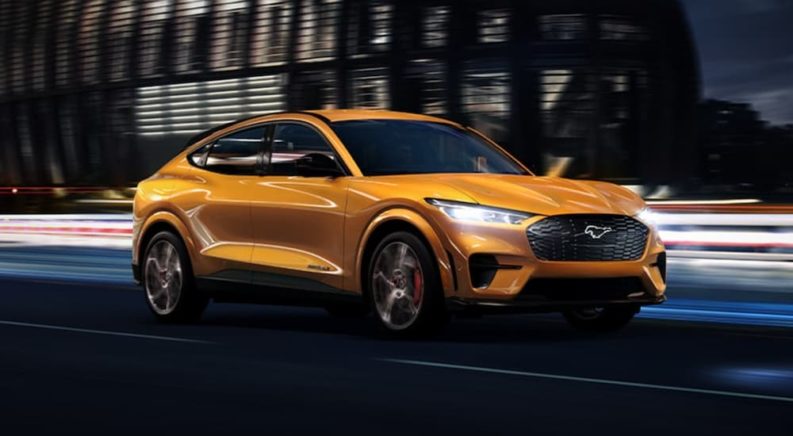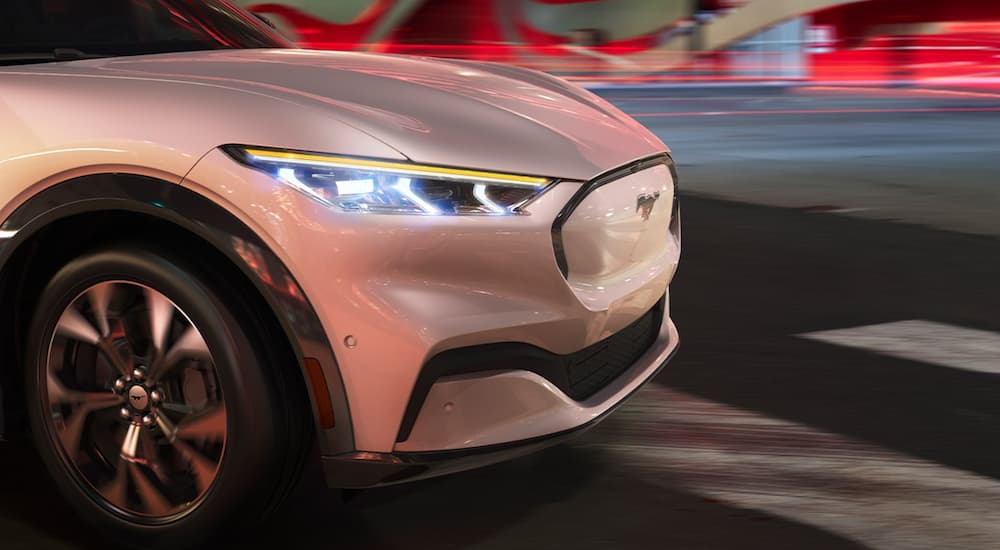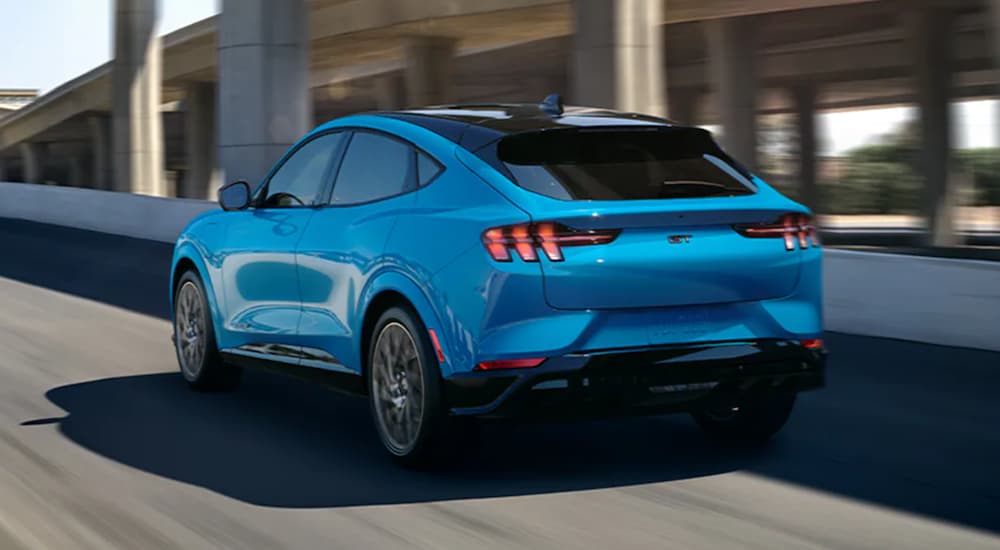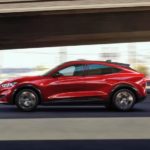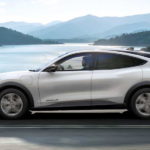The 2021 Ford Mustang Mach-E is the big talk of the town. Ford has been put into the spotlight, having their prize pony car turned into a full-on, all-electric crossover SUV. But this actually brings up more questions than answers. Yes, the Mach-E is an all-electric crossover, but how exactly does it stack up against the competition in both the combustible and electric divisions? How well does it get off the line versus the eco-friendly SUVs from competing companies? How are the charge times versus other electric vehicles? And how safe is it?
Anyone interested in the Mach-E, whether for knowledge or purchasing purposes, and how it stacks up when it comes to performance and range might be pleasantly surprised at the results. With the powertrain setup, the dual motors, and the onboard electronics, the Mach-E is a surprising entry in the electric SUV market. We can give a brief rundown of what you can expect from the Mach-E. This includes match-ups against the existing subcompact and compact SUVs on the market from the combustible category, as well as how it stacks up against other electric SUVs when it comes to range and charge times.
Safety vs Jeep Compass
Jeep’s compact crossover SUV, the Compass, is a popular choice among many SUV shoppers. It makes sense, really. It’s small, easily maneuverable, has a lot of the trademark personality traits of the Jeep brand, but stuffed into a compact family vehicle. In the department of safety, though, it’s interesting that despite having 70 standard and available safety features, the Compass isn’t quite as well rounded as the Mach-E. You might be wondering how, but a lot of it boils down to trim selection.
The lower-end trims of the Compass don’t come with a lot of standard driving aids, safety alerts, or road monitoring systems found in the Mustang Mach-E. For instance, if you want forward collision alerts or a security system from the Compass, you’re fresh out of luck for the base trim and many of the other lower-end trims. So you either have to purchase a separate package to attain those features or buy anything above the Limited trim to get them as standard features.
For the 2021 Ford Mustang Mach-E, it comes equipped with the Ford Co-Pilot360 Assist 2.0 across the entire trim line. So you get everything from Automatic Emergency Braking to the Lane Keep Assist System to Intelligent Adaptive Cruise Control, all in one go. No extras, no specials, no additional packages required. It also comes with a few surprise safety features you may not have been expecting, like reverse brake assist, speed sign recognition, and even interaction assist. It goes without saying that the Mach-E definitely has a leg up over the Jeep Compass when it comes to safety features and driver assists.
Performance vs Chevy Equinox
Another compact SUV that is quite popular on the market is the Chevy Equinox. The Equinox has gone through some ups and downs over the years, and the newest model year is strapped to a 1.5-liter 4-cylinder. The engine only produces 170 horsepower at 203 pound-feet of torque. The 2021 Chevy Equinox has been tested and put through the ropes and the performance – while definitely acceptable for a family-oriented SUV – is not good when measured against the Mach-E. In some tests, the Equinox managed 0 to 60 miles per hour in 8.7 seconds.
By comparison, the Ford Mustang Mach-E is powered by up to two electric motors. With the dual motors (one permanent magnetic motor on each axle), the Mach-E manages up to 346 horsepower and up to 428 pound-feet of torque. For even more performance, the Mach-E GT delivers a massive 480 horsepower and up to 634 pound-feet of torque. On the actual track, the standard Mach-E can reach 0 to 60 miles per hour in just 4.8 seconds, whereas the Mach-E GT has an estimated performance of 0 to 60 in 3.5 seconds.
In short, the Mach-E is more than twice as fast as the Chevy Equinox. You get more horsepower, more torque, more performance, and more off-the-line acceleration than Chevy’s compact SUV. If you wanted an all-electric vehicle with some oomph to it, the Mach-E definitely delivers, both under the hood and on the track. It certainly outperforms its nearest rival in the form of the Equinox.
Range vs Chevy Bolt EUV
When it comes to electric vehicles, the big tell about battery power is how far the vehicles can travel on a single charge. These days every company making an all-electric vehicle is determined to promote the range estimates, whether it be in rear-wheel or all-wheel drive. One of the nearest competitors for the Mach-E in the all-electric SUV category is yet another Chevy. This time, the Chevy Bolt EUV. When deciding which of the two vehicles is worth the price of entry, the topic of range is a surefire way to help make the decision more definitive.
For the Chevy Bolt EUV, it’s running on a single permanent magnetic motor powered by a 65-kilowatt battery pack with 288 lithium-ion cells. This nets the Bolt EUV up to 200 horsepower and 266 pound-feet of torque. According to the Environmental Protection Agency, the Bolt EUV settles in at around 247 miles of range on a full battery charge. That’s just below the originally estimated 250-mile range that Chevy was first touting.
With the 2021 Ford Mustang Mach-E you have a minimum range of 210 miles with the 75.7-kilowatt battery pack in an all-wheel drive format. On the maximum end of the range scale, you have up to 305 miles worth of travel with the extended range 98.8-kilowatt battery back configured in a rear-wheel drive format. So you gain a significant amount of travel range with the Mach-E compared to the Bolt EUV when you opt for the extended range configuration.
Charge Time vs Kia Niro
Another important facet of electric vehicles is charge times. How long it takes to charge an electric vehicle can be a make-it or break-it moment for some drivers. If you were weighing whether to get one specific electric SUV over another based on how long it takes to charge and how much range you get out of a charge, you might be interested to know how the Mach-E manages its battery pack power compared to something like the Kia Niro.
The Niro can charge to full capacity with a 39.2-kilowatt battery from a wall box with 7.4 kilowatts of power in about 6 hours and 10 minutes. With a domestic socket, you’re looking at 19 hours of charge time with an ICCB cable. If you opt for the 64-kilowatt battery pack, it takes about 7-and-a-half hours to charge from the wall box with 11 kilowatts of power. On the low-end of the scale, it can take up to 60 hours to charge from 0 to 100% from a domestic socket. The 39.2-kilowatt pack can add up to 26 miles worth of travel in about 2 hours using a Level 2 charging station. At a DC Fast Charging station with 100 kilowatts of power, you can regain up to 80% of the battery power in 54 minutes.
For the Ford Mach-E, you have several different ways to charge. The vehicle comes with a Ford Mobile Charger for 120 volt and 240-volt outlets. Charging it through a standard outlet will take about 95 hours to charge from 0 to 100%. Using a 240-volt outlet, you can get a full charge in about 15 hours. If you visit a Ford Connected Charge Station or have one installed, you can charge up the Mach-E to full in just under 10.9 hours. However, if you visit a FordPass station with a 150-kilowatt charger, you can charge from 10% to 80% in under 45 minutes. That’s about 17% faster than the Kira Niro. Thus, proving that the Mach-E is more than capable of competing with the competition, both in the combustible arena and the electric arena.
So, when you put it head to head against the competition, the 2021 Mustang Mach-E is the clear winner across the board.

